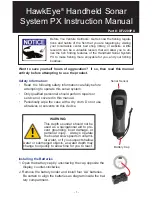
13
If you need a longer length cable than comes with the
transducer (30’), then purchase the optional 30’
extension cable,
Interphase
Part # 04-0014-008.
In addition to the above, the following considerations
should be observed:
1) Choose a location where there is the least amount
of acoustic noise, air bubbles or turbulence caused by
the boat’s movement. The transducer(s) should not be
located nearby or especially directly behind the
propeller.
2) Choose a location where the transducer(s) can be
mounted so that it will be level to the water’s surface
and will not be tilted to either side. Otherwise the
transducer(s) will not scan properly.
3) The transducer(s) must always remain
submerged, regardless of the speed of the boat and
should not be mounted where it could be damaged by
underwater obstacles or when loading on a trailer.
4)
DO NOT
locate the transducer(s) in the extreme
bow of the boat where it will be subject to intense
turbulence as the boat pounds through the water.
5)
DO NOT
locate the transducer(s) directly behind
any hull protrusion which will cause the water to be
turbulent when it reaches the transducer(s) or which
will obstruct the transducer’s forward looking view.
For displacement-hull power and sail boats, the thru-
hull installation is usually required.
DANGER: DO NOT
allow any solvents, i.e. gasoline,
acetone, to come in contact with the transducer(s) or
display unit as this may dissolve the plastic material.
Transom Transducer Installation
The transom transducers are attached to the boat with
heavy-duty stainless kick-up brackets to provide
protection against impact at speeds of
25 - 30 MPH.
When the water force exceeds this setting, the
transducer automatically kicks up and becomes non-
operational.
30’ Extension Cable
9-pin
Male
9-pin
Female
Interphase Part #
04-0014-008
Transom Mount Bracket in Released
Position
Suggested materials required for installation:
♦
Variable speed electric drill with a chuck
capacity of 10mm (3/8”) or larger.
♦
Hole saw or spade bit 19 mm (7/8”) for
transom hole to route cable and
connector
♦
Chamfer bit or 6 mm (1/4”) drill bit
♦
Drill bit No. 28 or 4 mm (9/64”)
♦
Drill bit 3 mm (7/64”)
♦
Marine bedding/sealing compound
♦
Note: Make sure your tooling is sharp and
of the correct diameter before proceeding.
Note: Will not
work at speeds
above 30MPH
Summary of Contents for Color Twinscope
Page 1: ...1 OPERATION MANUAL INTERPHASE INTERPHASE TWINSCOPE...
Page 83: ...83 Notes...
Page 84: ...84...
Page 86: ...86...
Page 88: ...88...

































